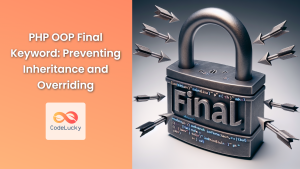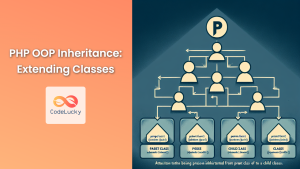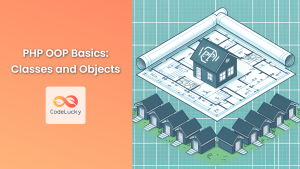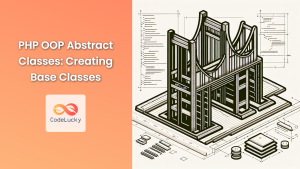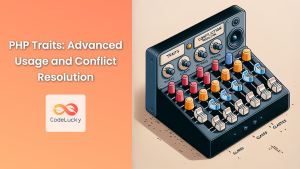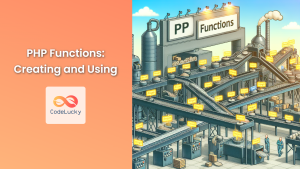In the world of Object-Oriented Programming (OOP) in PHP, we often focus on creating and using objects. However, it's equally important to understand how to properly clean up these objects when they're no longer needed. This is where the PHP destructor comes into play. 🧹✨
What is a Destructor?
A destructor is a special method in a class that is automatically called when an object is destroyed or goes out of scope. In PHP, the destructor method is named __destruct(). It's used to perform any necessary clean-up operations before the object is removed from memory.
Let's dive into the details with some practical examples!
Basic Destructor Example
Here's a simple example to demonstrate how a destructor works:
<?php
class FileHandler {
private $file;
public function __construct($filename) {
$this->file = fopen($filename, 'w');
echo "File opened.<br>";
}
public function writeContent($content) {
fwrite($this->file, $content);
echo "Content written.<br>";
}
public function __destruct() {
fclose($this->file);
echo "File closed.<br>";
}
}
$handler = new FileHandler('example.txt');
$handler->writeContent('Hello, CodeLucky!');
// The destructor will be called automatically when the script ends
?>
In this example, we create a FileHandler class that opens a file in its constructor, provides a method to write content, and closes the file in its destructor.
When we run this script, we'll see the following output:
File opened.
Content written.
File closed.
The destructor ensures that the file is properly closed, even if we forget to do it explicitly in our code. This helps prevent resource leaks and ensures proper cleanup. 🚰
Destructor in Inheritance
Destructors are also inherited in PHP. Let's see how this works with an example:
<?php
class Animal {
protected $name;
public function __construct($name) {
$this->name = $name;
echo "{$this->name} is born.<br>";
}
public function __destruct() {
echo "{$this->name} is no more.<br>";
}
}
class Dog extends Animal {
public function __construct($name) {
parent::__construct($name);
echo "{$this->name} barks.<br>";
}
public function __destruct() {
echo "{$this->name} stops barking.<br>";
parent::__destruct();
}
}
$dog = new Dog('Buddy');
// Script ends, destructors are called
?>
When we run this script, we'll see:
Buddy is born.
Buddy barks.
Buddy stops barking.
Buddy is no more.
Notice how both the Dog and Animal destructors are called, in that order. This demonstrates the importance of calling the parent destructor in child classes to ensure proper cleanup at all levels of inheritance. 🐕🐾
Destructor and Exception Handling
Destructors can be tricky when it comes to exception handling. Let's look at an example:
<?php
class DatabaseConnection {
private $connection;
public function __construct() {
$this->connection = new mysqli('localhost', 'username', 'password', 'database');
if ($this->connection->connect_error) {
throw new Exception('Connection failed: ' . $this->connection->connect_error);
}
echo "Connected successfully.<br>";
}
public function query($sql) {
$result = $this->connection->query($sql);
if (!$result) {
throw new Exception('Query failed: ' . $this->connection->error);
}
return $result;
}
public function __destruct() {
$this->connection->close();
echo "Connection closed.<br>";
}
}
try {
$db = new DatabaseConnection();
$result = $db->query("SELECT * FROM non_existent_table");
} catch (Exception $e) {
echo "Caught exception: " . $e->getMessage() . "<br>";
}
// Destructor is called even if an exception is thrown
?>
In this example, we're simulating a database connection. If we run this script (assuming the database connection succeeds), we'll see:
Connected successfully.
Caught exception: Query failed: Table 'database.non_existent_table' doesn't exist
Connection closed.
Even though an exception is thrown, the destructor is still called, ensuring that the database connection is properly closed. This highlights the importance of destructors in resource management and error handling. 💾🔒
Destructor Timing and Garbage Collection
It's important to note that in PHP, the exact timing of when destructors are called can be unpredictable due to its garbage collection mechanism. Let's see an example:
<?php
class LargeObject {
private $data;
public function __construct() {
$this->data = str_repeat('x', 1000000); // Allocate 1MB of memory
echo "Large object created.<br>";
}
public function __destruct() {
echo "Large object destroyed.<br>";
}
}
function createObjects() {
for ($i = 0; $i < 10; $i++) {
$obj = new LargeObject();
}
echo "Function ended.<br>";
}
createObjects();
echo "Script continues...<br>";
gc_collect_cycles();
echo "Script ended.<br>";
?>
The output might vary, but it could look something like this:
Large object created.
Large object created.
Large object created.
Large object destroyed.
Large object created.
Large object destroyed.
Large object created.
Large object destroyed.
Large object created.
Large object created.
Large object created.
Large object created.
Large object created.
Function ended.
Script continues...
Large object destroyed.
Large object destroyed.
Large object destroyed.
Large object destroyed.
Large object destroyed.
Large object destroyed.
Large object destroyed.
Script ended.
As you can see, some objects are destroyed before the function ends, while others persist until after we manually trigger garbage collection with gc_collect_cycles(). This unpredictability means you shouldn't rely on destructors for time-sensitive operations. ⏱️🔄
Best Practices for Using Destructors
-
Resource Cleanup: Use destructors primarily for cleaning up resources like file handles, database connections, or network sockets.
-
Keep It Simple: Avoid complex logic in destructors. They should be straightforward and focused on cleanup tasks.
-
Don't Rely on Order: Since the order of destruction for multiple objects isn't guaranteed, don't make your destructors dependent on other objects.
-
Be Careful with References: If your object holds references to other objects, those references might already be destroyed when your destructor runs.
-
Consider Alternative Cleanup Methods: For more control over when cleanup occurs, consider implementing a separate cleanup method that you can call explicitly.
Here's an example incorporating these best practices:
<?php
class ResourceManager {
private $resources = [];
public function acquireResource($name) {
$this->resources[$name] = "Resource $name acquired";
echo "Resource $name acquired.<br>";
}
public function releaseResource($name) {
if (isset($this->resources[$name])) {
unset($this->resources[$name]);
echo "Resource $name released.<br>";
}
}
public function cleanup() {
foreach ($this->resources as $name => $resource) {
$this->releaseResource($name);
}
}
public function __destruct() {
$this->cleanup();
echo "ResourceManager destroyed.<br>";
}
}
$manager = new ResourceManager();
$manager->acquireResource('A');
$manager->acquireResource('B');
$manager->releaseResource('A');
// Let the destructor handle the rest
?>
This script will output:
Resource A acquired.
Resource B acquired.
Resource A released.
Resource B released.
ResourceManager destroyed.
By providing a separate cleanup() method, we allow for manual resource release when needed, while still ensuring all resources are released when the object is destroyed. 🧼🔧
Conclusion
Destructors in PHP OOP provide a powerful mechanism for automatic cleanup of objects. They ensure that resources are properly released and any necessary finalization code is executed before an object is removed from memory. However, it's crucial to use them judiciously and understand their limitations, particularly in terms of execution timing and exception handling.
By mastering destructors, you can write more robust and resource-efficient PHP applications. Remember, a well-designed destructor can be the unsung hero of your code, quietly tidying up behind the scenes and preventing resource leaks. 🦸♂️🧹
Happy coding, CodeLucky developers! May your objects always be properly destructed and your resources always cleanly released. 🚀💻



